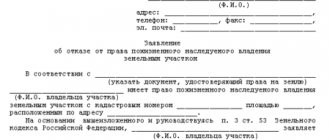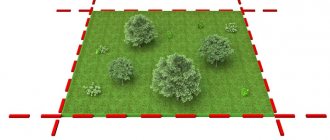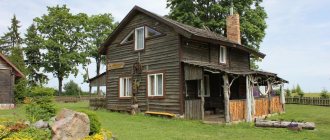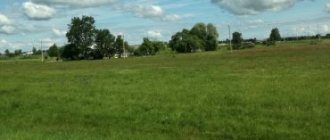Elena Shereshovets spoke about the formation and maintenance of the MKD land plot
On the first day of the online seminar, the Head of the Expert Council of the P1 Association, Elena Shereshovets, examined what changes have occurred in the legislation in the field of land and real estate in 2021. We also discussed topics such as:
- formation of a site for an apartment building;
- protection of the rights of premises owners during its registration;
- transfer of ownership of the site.
Among these issues, we discussed the topic of responsibility for the maintenance of the land.
Watch the demo on the YouTube channel of the P1 Association ➡️
Is it necessary to pay tax on the territory under the MKD?
After the privatization of land under MKD, it is automatically subject to taxation, since it becomes private property. Many people are interested in how much residents need to pay, and how to properly process and organize payments. Taxes are paid starting from the date of cadastral registration of the land located under the house. The tax amount is divided in proportion to the shares of each home owner. The size of such a share will be equal to the quotient after dividing the personal area of the tenant’s premises by meters and the total area of all premises belonging to the residents.
The tax base of a plot is its cadastral value, calculated taking into account an analysis of the market value of various land holdings in the Russian Federation. If the owner of the apartment is an individual entrepreneur or a legal entity, he needs to calculate the tax amount independently. If we are talking about individuals, they will be sent notifications from the tax office with ready-made calculations. Citizens belonging to preferential categories are exempt from paying such tax.
Owners pay for the maintenance of the land plot, which is part of the common property of the house
Management organizations are responsible for the maintenance of the land plot if it is formed and is part of the common property. The common property of the residents of the house is a plot with the following characteristics:
- it has been formed (clause 4, part 1, article 36 of the RF Housing Code);
- its boundaries and size are determined in accordance with the requirements of the law (clause “e”, clause 2 of RF PP No. 491);
- State cadastral registration was carried out in its respect (Part 5, Article 16 of the Federal Law of December 29, 2004 No. 189-FZ).
The land plot is transferred into ownership free of charge from the moment of its formation. Until this time, it is the property of a public legal entity (clause 67 of the resolution of the Plenum of the Supreme Court of the Russian Federation, Supreme Arbitration Court of the Russian Federation dated April 29, 2010 No. 10/22).
Elena Shereshovets noted that if the boundaries of the land plot adjacent to the apartment building are not established, the plot itself is not specified, there is no plan diagram, the management authority is not obliged to maintain such a territory. Citizens and legal entities are responsible only for the condition of the plots that are in their ownership or possession.
In this case, authorities or a court may oblige owners to maintain the territory adjacent to their land plots - on the basis of federal law or an agreement. This conclusion was made by the Supreme Court of the Russian Federation in paragraph 7 of the Review of Judicial Practice No. 4 (2018). Find out more from the online seminar materials below the article.
Can the local self-government not form a plot for an apartment building in the absence of money?
Official website of the Supreme Court of the Russian Federation
As the Court explained, when one person acquires all residential and non-residential premises in an apartment building, he becomes the owner of the entire plot of land if it has already been registered in the cadastral register.
AG experts supported the position of the Supreme Court, which, in their opinion, fills the legislative gap.
At the same time, they separately highlighted the conclusion of the Supreme Court that resort lands can be in the right of common ownership of the owners of premises in an apartment building. The Supreme Court published Determination No. 308-ES20-18388 in case No. A32-17099/2019 regarding the emergence of ownership of land under an apartment building for a legal entity - the owner of all apartments in it.
In March 2021, in the Krasnodar Territory, the ownership of a land plot in the category of lands of specially protected areas and objects with the type of permitted use “resort construction” with an area of 852 square meters was registered in the Unified State Register of Real Estate. m, on which an apartment building owned by Kubansantehmontazh LLC is located. In turn, the company filed several lawsuits to recognize its ownership of this site.
In case No. A32-25129/2013, it was established that the plaintiff acquired ownership of an apartment building on the basis of a purchase and sale agreement with Visa LLC, and the transfer of ownership was registered in the Unified State Register of Real Estate on October 11, 2002. At the same time, the court recognized as a cadastral error the information previously contained in the state real estate cadastre about the disputed land plot. In case No. A32-4030/2018, the courts found that the land plot under an apartment building passes into the common shared ownership of the owners of the premises in such a building free of charge, and the corresponding claim should be brought to the Krasnodar Territory. In turn, in case No. A32-47190/2018, the company was refused to recognize as illegal the refusal of the Rosreestr Office for the Krasnodar Territory to state registration of ownership of the specified land plot. Then the court proceeded from the fact that in relation to the disputed land plot the property right of the Krasnodar Territory was registered, therefore, between the company (the owner of the premises in an apartment building) and the above-mentioned subject of the Russian Federation there is a dispute about the right to the named land plot, which is subject to resolution in the manner of claim proceedings with another subject composition of the parties.
In this regard, the Kubansantehmontazh society filed a lawsuit against the Department of Property Relations of the Krasnodar Territory to recognize the ownership rights of a subject of the Russian Federation to the land plot as absent and to recognize the ownership rights to the disputed object. According to the plaintiff, the disputed plot was registered on the cadastral register on March 18, 2013 at the expense of the company on the recommendation of the Department based on its letters about the allocation of a plot for a house. Therefore, it is “Kubansantehmontazh” that is the owner of the site on which this house is located, from the moment the site is formed, regardless of the state registration of the right to it by force of law.
Three courts rejected the company's claim, citing the fact that the disputed plot of land is located on the lands of a resort of regional significance and belongs to the lands of specially protected areas, therefore it cannot be transferred to private ownership. The courts added that the right of common shared ownership of the disputed land plot could not arise on the basis of the norms of housing legislation, since the plaintiff is the only owner of apartments in a residential building located on the disputed plot, and the provisions of Part 1 of Art. 16 of the Law on the Introduction of the Housing Code of the Russian Federation and Part 1 of Art. 36 of the Housing Code of the Russian Federation do not apply to the issue of transferring such a land plot into the ownership of the sole owner of the apartment building.
They also considered that, within the meaning of a number of provisions of the Civil Code of the Russian Federation, the emergence of the right of common shared ownership of the common property of an apartment building, including a land plot, presupposes the mandatory presence of a plurality of co-owners of the premises located in such a building, and two-apartment buildings do not belong to multi-apartment buildings, the co-owners of the premises in which acquire the right of common shared ownership of the land plot under such a house in a special manner. In turn, the society’s demand to recognize the defendant’s land plot as absent is an inappropriate method of defense, since the plaintiff has not registered ownership rights and there are no grounds for recognition of such a right.
After studying the materials of the case, the Judicial Collegium for Economic Disputes of the Supreme Court, with reference to a number of normative legal acts, its own practice and legal positions of the Constitutional Court of the Russian Federation, recalled that the qualifying feature of an individual residential building is the presence of rooms (not apartments) in it, the main criteria for classifying a residential building Multi-apartment housing is a collection of several apartments with independent access to an adjacent land plot or to common areas, as well as the presence of elements of common property.
As the Supreme Court explained, the lower courts did not apply the relevant rules of law in the case under consideration and did not examine the presence or absence of signs of a multi-apartment residential building in the disputed object, despite the fact that in the certificates of state registration of property rights of the company the disputed object is named as a two-apartment residential building, in an extract from EGRN is like a two-story residential apartment building. “The courts made an unfounded conclusion that if all apartments in an apartment building have one owner, then the rules of clause 4, part 1, art. 36 and art. 16 of the Housing Code do not apply,” the definition emphasizes.
The board added that when one person acquires all residential and non-residential premises in an apartment building, and therefore all shares in the right of common shared ownership of common property, such a person, from the moment of state registration of the right to the last apartment or non-residential premises in an apartment building, when the land plot has already been registered in the cadastral register, becomes the owner of the entire plot.
“The court also made an unfounded conclusion that the land plot on which the multi-apartment residential building is located cannot be transferred to private ownership if this plot is located on the lands of specially protected natural areas,” the judicial act noted. As the Supreme Court explained, as a general rule, restricted lands in specially protected natural areas that are in state or municipal ownership are not granted into private ownership, except in cases established by federal laws. At the same time, the right of common shared ownership of the owners of premises in an apartment building to the land plot on which the house is located arises by force of law - the provisions of the Housing Code and the Introductory Law, including if the apartment building is located within the boundaries of a specially protected natural area territory, regardless of whether the house was put into operation before the creation of a specially protected natural area or after (except for cases of erection of unauthorized buildings), which corresponds to the rules of clause 2 of Art. 27 Land Code of the Russian Federation.
As the Court pointed out, taking into account that the ownership of a land plot formed for an apartment building arises by force of law and the ownership right to it is registered in the Unified State Register of Real Estate for another person, and within the framework of a specific dispute, numerous methods of protecting the right chosen by the court did not resolve the legal conflict about legal claims to the object of real rights, then the methods of protecting the right chosen by the plaintiff in this case correspond to the explanations contained in paragraph 52 of the Resolution of the Plenum of the Armed Forces of the Russian Federation and the Supreme Arbitration Court of the Russian Federation No. 10/22 of April 29, 2010, and are appropriate. In this regard, the Supreme Court overturned the judicial acts of the lower courts and returned the case for a new trial at the first instance.
Commenting on the ruling of the Supreme Court, Anna Minushkina, Chairman of the Minushkina and Partners Agency, noted that it filled the legislative gap regarding what to do with the ownership of a plot under an apartment building if the owner of all apartments is one person. “It is logical to assume that if the owner of all apartments is the same person, then “sole” ownership arises. However, it took the plaintiff in this case many years to confirm his right of “sole” ownership of the land plot under the apartment building, and therefore the Court’s conclusion is quite reasonable that if all apartments in an apartment building have one owner, then he the rules of housing legislation on the right of ownership of the common property of the owners of the premises of an apartment building apply,” the expert believes.
According to the lawyer, the Supreme Court also made an important conclusion, according to which the right of common shared ownership of the owners of premises in an apartment building to the land plot on which the house is located arises also if the apartment building is located within the boundaries of a specially protected natural area , since the current legislation provides for the emergence of ownership rights to such a land plot by virtue of a direct indication of the law. “I believe that this conclusion was made taking into account the principle of the unity of fate of land plots and real estate objects firmly associated with them, as well as in order to ensure the rights of owners of premises in apartment buildings,” suggested Anna Minushkina.
Lawyer, senior partner of Altavista Law Firm Valeria Arshinova supported the conclusions of the Supreme Court that the plaintiff had the right to consider this dispute at his request, since he was legally and actually connected with both the land plot and the construction projects on it.
“Refusing the claim, the court of first instance, referring to judicial acts in related cases, pointed to an apartment building, but did not establish the signs of a residential building. The Supreme Court of the Russian Federation drew attention to this, since the court of first instance should have analyzed the title documents in more detail. An important conclusion in the definition also concerns the fact that resort lands can be in the common ownership of “multi-apartment owners” - this is of significant importance for practice,” the expert concluded. Zinaida Pavlova
The management authority is responsible for the condition of the local area included in the general property of the apartment building
Owners of premises in apartment buildings bear the burden of expenses for the maintenance of common property (Parts 1, 3, Article 39 of the Housing Code of the Russian Federation). At the same time, the management organization ensures its proper maintenance (Article 161 of the RF Housing Code).
According to Art. 162 of the Housing Code of the Russian Federation, the common property of an apartment building is an essential condition of the management agreement. The property of the house includes only a formed land plot, the boundaries of which are determined on the basis of state cadastral registration data (clause “e”, clause 2 of RF PP No. 491). In this case, the owners of premises in an apartment building pay for its maintenance (Article 154 of the Housing Code of the Russian Federation).
As Elena Shereshovets noted, the management organization is responsible for maintaining the local area only if two conditions coincide:
- The site is the common property of the owners of premises in the apartment building.
- Territory maintenance services are included in the management agreement.
Watch the full video of the first day of the online seminar to learn what to do if local regulations and courts are in favor of requiring the HO to maintain an undeveloped area of the house.
What is the difference between new and old MKDs
The Housing Code also separately stipulates another nuance regarding the year of construction of an apartment building. According to the rules, the land under houses built before 2005 should automatically become the public shared property of all residents of MKD apartments. However, any person who has purchased secondary housing of this type must independently check whether the territory under the MKD is included in his property. To carry out a free transfer of rights, you must:
- The territory under the MKD had clear boundaries and had a cadastral plan established by a local government body.
- Land management work was completed before the Housing Code of the Russian Federation came into force, that is, before 2005.
- The area near the house was included in Rosreestr.
There are no criteria in the regulatory legal acts for assessing the sanitary condition of the local area of the house
On the second day of the online seminar, the Chairman of the Board of the P1 Association, the head of RosKvartal, Boris Valit, focused on practical topics related to the land plot under an apartment building. We have sorted out:
- who should maintain the roads;
- what are the requirements for MSW accumulation sites;
- how to install a barrier and road signs in the yard;
- how to take part in the national project “Comfortable Urban Environment”.
You can learn briefly about these topics from the demo video:
Watch the demo on the YouTube channel of the P1 Association ➡️
One of the questions that Boris Valit considered was whether there are any criteria for assessing the pollution of the local area. They are not established by law. The regulations stipulate only the requirements for the composition, frequency and order of work for the proper maintenance of local areas.
The expert cited regional practice as an example - decision of the Tver City Duma dated October 16, 2014 No. 368. Clauses 6.140–6.145 of this document state how often the yard should be cleaned and its sequence.
First, they clean the sidewalks, then the pedestrian paths and courtyard areas. Cleaning, except for snow removal, which is carried out during snowfalls, is carried out until 13.00. When manually clearing sidewalks and internal driveways, snow must be removed completely, under a scraper. In the absence of improved coatings, the snow is removed under the engine, leaving a layer for subsequent compaction.
Based on this, we can conclude that if the territory is not cleaned according to the standards established in this document, then it can be considered contaminated. To avoid this, the management company and the homeowners association must carry out all work prescribed by law in full, within the specified time frame or at the established frequency. There are no other criteria for assessing the quality of work performed.
Is it possible to place commercial objects in the local area?
Section order
This procedure is quite complicated, but it is still possible. First of all, owners need to establish whether there is a possibility of dividing an apartment building in kind from a technical point of view. To this end, the latter need to seek help from expert organizations that can conduct an independent construction and technical examination and provide a comprehensive answer regarding the possibility and procedure for a real division.
Example. An apartment building, consisting of two rooms, is located on a plot of land with a total size of forty thousand square meters. Each apartment has a separate entrance, independent water supply and sewerage. The only thing that unites the building is the roof and foundation. Based on the results of the construction and technical examination, it was found that the actual division of the living space seems possible.
In case of receiving a positive expert opinion regarding the possibility of real division of the house, all owners need to collect the appropriate permitting documentation for carrying out work on reconstruction or redevelopment of the property. To do this, you should contact the territorial branch of the municipal authority located at the location of the disputed land plot.
Seek legal advice before you begin collecting documents. These disputes are extremely complex, and there is a high risk of refusal to divide the housing. It’s better to get help now than to urgently look for a lawyer later!
Thus, the next stage will be the division of the structure by allocating shares in kind. As a result, from one multi-apartment premises two or more independent parts of a residential building will be formed.
Remember:
- After the owners decide on the real shares of the disputed real estate, the latter should begin the procedure for dividing the land plot located under it, as well as its local area. In this case, some nuances provided for by law should be taken into account.
- The division of a plot may be permitted only if the newly formed real estate objects retain the same permitting purpose as the original plot.
- The second condition for the division of land is regulated by Art. 1 of the Land Code of the Russian Federation, which defines the principle of indivisibility of the fate of allotments with the premises located on them. In this case, it is meant that the owner who received a specific share of residential real estate will also receive ownership of part of the land located under it.
Other issues regarding the maintenance of a site under an apartment building can be found in the materials of the online seminar
During the two days of the online seminar, together with Elena Shereshovets and Boris Valit, we discussed many topics and issues that relate to the maintenance of land plots for apartment buildings. Including sorted out:
- what is an easement?
- what to do if excavations begin in the courtyard of the house;
- how to install road signs in the local area;
- how to raise additional money for landscaping.
You will learn more information from the videos: they are attached immediately below the article. You will find reviews of judicial practice, algorithms and advice, and answers to questions from participants.
Definition of an apartment building
According to the Decree of the Government of the Russian Federation dated January 28, 2006 No. 47, the concept of an apartment building can be defined as a building that is equipped with two or more premises for living, with separate exits to common areas or to the local area.
Expert opinion
Stanislav Evseev
Lawyer. Experience 12 years. Specialization: civil, family, inheritance law.
In addition, a feature of an apartment building is that such real estate has signs of joint ownership, for example, a common roof, foundation, elevators, landings, etc.
Formally, the so-called houses “for two owners” also fall under the concept of an apartment building. Court practice increasingly comes down to the fact that if each apartment has a separate exit/entrance and it does not pass through a common area, then such a building cannot be considered an apartment building (Decision of the Judicial Collegium for Civil Cases of the Armed Forces of the Russian Federation).
Where to submit documents
Documents for state registration can be submitted in person through state submission centers (MFC), reception offices of the branch of the Federal State Budgetary Institution "FKP Rosreestr" or sent by mail (necessarily with a list of investments and declared value) or electronically through the Rosreestr portal. The registration period will be seven working days; if documents are submitted through the government submission center, the registration period will be nine working days.
The material was published on the official website of Rosreestr on July 12, 2017
How to register land near a house as property
The land plot on which the apartment building with the adjacent territory is located can be registered as the common shared ownership of the owners of the premises of the apartment building (MKD). According to Mikhail Kyurdzhev, the basis for registering the right is the decision of the owners of the apartment building, as well as the cadastral passport of the land plot .
It is necessary to check using the public cadastral map whether the land plot has been formed for a specific house. If it is formed and you know its number, you need to send a request to receive information about the site on the Rosreestr website. After paying and receiving an extract with a passport and a certificate of ownership of residential or non-residential premises in this house (now, instead of a certificate of ownership, they issue an extract and the Unified State Register of Real Estate), contact the State Grant Center. At the public services center, you must pay a state fee of 600 rubles. and submit the documents, after three days the extract on the right to a share in the common ownership of the site should be ready.
If the plot under the house is not formed, then the residents themselves are responsible for registering the right. Usually they organize a general meeting, enter into an agreement with a cadastral engineer, pay for the preparation of a boundary plan, and appoint a representative. The latter fills out an application and submits a package of documents to Rosreestr.
In order to issue a cadastral passport for a land plot, it is necessary to carry out land surveying. A cadastral engineer is preparing a land surveying project. Next, it is necessary to coordinate the draft boundaries with the owners of neighboring plots (if there are any) or with the Moscow government (if all the land around belongs to the city), Mikhail Kyurdzhev describes the procedure.
As a rule, a cadastral engineer takes data about the territory being serviced from the operating organization (that is, the area that is actually maintained by the owners of apartment buildings is taken into account, paying the costs of operating and cleaning the house itself and the surrounding area), explains Mikhail Kyurdzhev.
The boundary plan is approved by the Moscow City Property Department and then submitted to public hearings, at which the owners of the residential building approve (or do not approve) the survey project by an absolute majority of votes. “This procedure is legal and prescribed in Art. 46 Civil Code. It exists so that owners can familiarize themselves with the boundary plan, ask questions to the designers, and make suggestions. After the project is approved, the actual boundary work begins. As a rule, they cost about 30–40 thousand rubles. from one house.
After that, with a boundary plan in hand, the owners apply to Rosreestr so that their plot can be included in the cadastre,” adds Maria Litinetskaya.
Conditions for recognizing the local area and land under the apartment building as common property.
The plot under the house and the adjacent territory, on which important infrastructure facilities and landscaping elements are located, become common property.
Only the Unified State Register and the cadastral registration authority can provide accurate information about what is included in the common property of a multi-storey building, after surveying and establishing boundaries.
Only a legally registered plot becomes the shared property of the residents.
Responsibilities of the owner of a land plot for its maintenance.
Regardless of whether the owner himself uses the land of the apartment building or rents it out together with the apartment for temporary use, he is obliged to:
- use the land only for its intended purpose;
- do not harm the environment;
- do not violate established boundaries;
- remember that the property is shared and respect other shareholders;
- do not interfere with management companies and homeowners associations to carry out repair and maintenance work.
So at what point does ownership of land under an apartment building arise? When a person buys an apartment in a multi-storey building, he automatically receives the right to use the land, but this does not mean that the procedure for privatizing land under an apartment building is completed.
The owner of the apartment becomes the full owner of the plot, provided that it is formed and registered with cadastral and tax authorities. In this case, the owner can dispose of his property in the manner prescribed by law in relation to shared ownership.
Use of land near the house
There is a text of the Rules for the maintenance of property in houses with a large number of apartments; it talks in detail about what the local area of any property consists of:
- These are any objects without which normal operation of the house becomes impossible;
- Heating points;
- Transformer substations;
- Fire lanes;
- Collective parking lots and clothes dryers;
- Areas for children's recreation and sports;
- Elements involved in landscaping and landscaping;
- A plot of land with an erected building.
Owners do not have the right to restrict access to the land located around the house.
It is only possible to install paid parking, place advertising boards, and lease out part of the area.
Money from these activities can be used for general house needs.
Only at a general meeting can residents decide what exactly this or that object will be used for.
The main and most common purpose is the installation of fencing posts, arrangement of parking lots, planting trees, construction of entertainment areas.
received should also be distributed collectively .
Why do you need land ownership near your home?
Residents of the apartment complex become full owners of the plot, which means they receive additional opportunities to manage their common land. Land ownership rights, according to lawyers interviewed by the editors, are not limited. The owners have the right to decide even to build on the site in accordance with the procedure established by law or to transfer part of the site for rent, they explain.
“Apartment owners can distribute land among themselves for surface parking in the yard, build or demolish any landscaping elements, install a barrier at the entrance to the yard or fencing the entire territory, rent out part of the land,” the managing partner of Metrium Group gives examples. Maria Litinetskaya. In addition, they can protect themselves from infill development, because often, if the land remains in municipal ownership, the authorities give it away for construction, which directly contradicts the interests and comfort of residents of nearby houses, she believes.
At the same time, along with rights come responsibilities. In particular, the owners of apartment buildings will have to independently resolve issues of property maintenance (leisure areas, roads and sidewalks, parking spaces), explains Maria Litinetskaya.
In what cases is the municipality the owner of the land under a residential building?
Local authorities may be the owner of land plots under residential buildings, in which all apartments belong to the municipal housing stock. It can be:
- houses built according to special programs, with the distribution of apartments under a social rental agreement;
- new buildings for the resettlement of dilapidated and emergency housing;
- old residential buildings whose residents did not privatize their square meters.
In all other cases, land without a cadastral number and designated boundaries formally belongs to local governments.
If the land plot is not formed, the city administration can sell or lease it.
EXAMPLE: Construction is planned on the territory. The construction site is too small, and construction may affect the adjacent area of the neighboring apartment building. How does the developer solve the problem? He comes to the municipality, explains his situation and learns that, fortunately for him, the neighboring plot is not formed and does not have clear boundaries. The municipality, which has the right to establish the boundaries of land plots, organizes land surveying taking into account the wishes of the developer.
The administration motivates its actions by replenishing the budget through rent from the developer. And residents of the apartment complex will end up with a reduced area that has no parking, no playground, or even a clothes dryer. This would have been impossible if the owners of the apartment buildings had taken the initiative earlier.
Not long ago, the State Duma adopted a law to simplify the procedure for land acquisition. This is explained by the desire to develop an untapped and unregistered territory. In fact, any plot that a potential investor likes may end up being sold in agreement with an unscrupulous official.
Get information on the Public Cadastral Map
The most convenient way to find out the legal status is with the help of the Public Cadastral Map on the Rosreestr website: you will receive an unambiguous report from the government body on whether the land plot under your apartment building has been formed.
To get information, go to the Public Cadastral Map page, select your city and enter your address. Or, if you know the coordinates of the house on a geographic map, indicate them.
Having found the area of interest, click on it. A window will open in which all available data will be collected: exact address, area, cadastral value, form of ownership, legal status of the land plot and others. The status of a site refers to its category and type of permitted use.
This data must be verified by ordering an extract.
In addition to referring to the Public Cadastral Map, there are several other ways to find out the legal status of a land plot:
- request information from local authorities,
- obtain information from the Office of the Federal Service for State Registration, Cadastre and Cartography.
Any owner of apartment buildings, a group of initiative owners, a management organization or TSN can make a request.
If the plot has already been formed and registered with the cadastral register, it passes free of charge into the common shared ownership of the owners of the premises in the apartment building.
How to form a land plot under a blocked building
Rules for dividing a land plot in common ownership
In order to begin the procedure, it is necessary to organize a meeting of the owners of the site and obtain the consent of everyone. The progress of the meeting and voting results are reflected in the minutes. The minutes of the meeting are a mandatory document as part of the package of documents. It is attached to the statement of intention to divide the territory between the owners.
An owners meeting is not always required. The exception is if the decision to divide was made during a trial, or the land was allocated by a municipal or federal enterprise.
After this, an agreement is prepared between the participants in the section. It states which part will belong to whom. The agreement specifies their area and location.
After the redistribution of territory, a scheme must be drawn up. It indicates the plan of the boundaries of the divided plots, their area, coordinates on the ground, red lines, plans for the adjacency of the land. Based on the data obtained, subject to approval of the division scheme, the specialist develops a cadastral plan.
Arbitrage practice
As we have already noted, there is a rich jurisprudence in cases concerning the ownership of the adjacent territory of an apartment building, as well as challenging the payment for its cleaning. The owners of the premises in the house and management companies, as well as the residents of the house, are constantly suing each other over the land plot under the apartment building.
Read more about disputes regarding payment for cleaning local areas in this article.
Above we cited Resolution of the Plenum of the Supreme Arbitration Court of the Russian Federation No. 10, Plenum of the Supreme Arbitration Court of the Russian Federation No. 22 of 04/29/2010. The case considered in it talks about mutual claims by neighbors of an apartment building who could not divide the adjacent territory. One neighbor had small buildings near her house that were disturbing the other resident of the house.
During numerous legal proceedings, the neighbors' claims were disputed several times, and various decisions were made in favor of one or the other owner of the premises in the apartment building. Some judges referred to the 30-year procedure for using the land plot under the MKD. Others abolished this order.
As a result, the Supreme Court of the Russian Federation judged everyone, citing Federal Law No. 189 of December 29, 2004 “On the entry into force of the Housing Code of the Russian Federation.” By law, this land plot under the house is considered the common property of the owners of the premises in the apartment building.
If ownership of a real estate property passes to several owners, then the right to a land plot passes in proportion to the shares of ownership in the house (Article 37 of the Land Code). If ownership of a house passes to several owners, then the procedure for using the local area is determined taking into account the share in the ownership of common property in the apartment building.
The Supreme Court of the Russian Federation emphasized that in this case, the owners of premises in an apartment building, by the right of the legal owners of the land plot under their house, can demand the elimination of any violations of their interests (Article 305 of the Civil Code of the Russian Federation).







